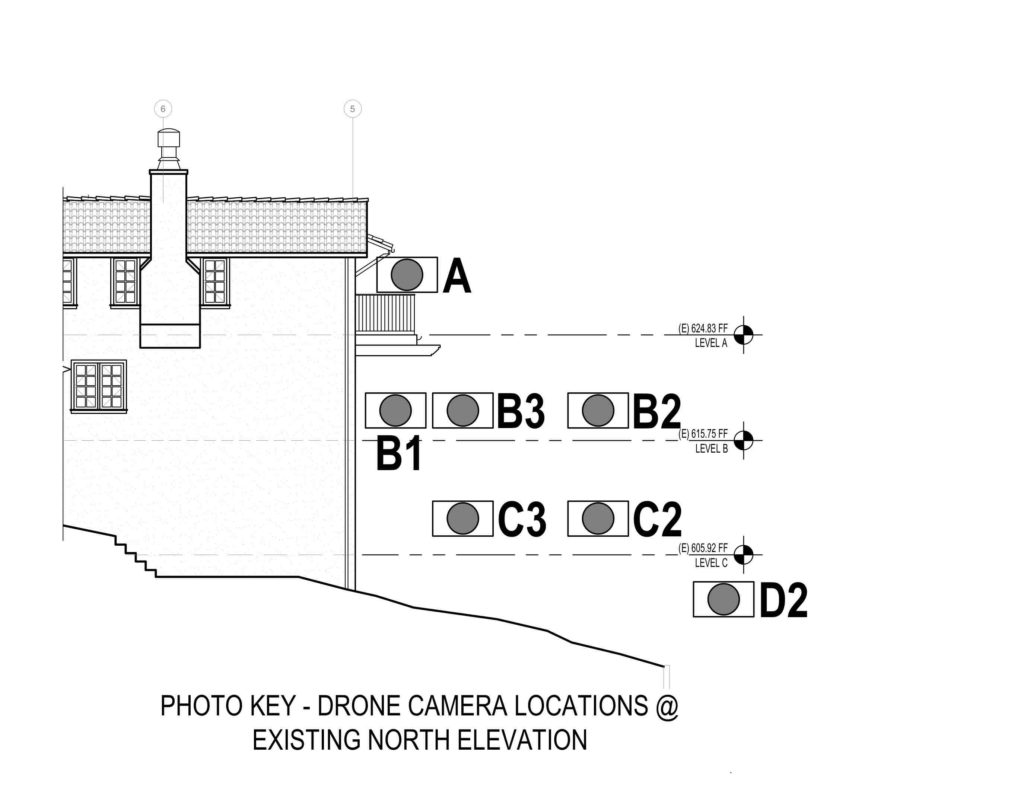Cecil Spencer, AIA, CSI, LEED AP, of Architectural Analysis & Design in Rohnert Park, CA, faced a dilemma when he needed to get a permit for his clients to build a large deck onto their home. Building a deck isn’t exactly a tall order, only this home was perched on a steep slope in the Oakland Hills high above Oakland, California – and faced an even steeper permit process.
“The neighborhood has ordinances for new additions in neighborhoods in regard to privacy and views. They want to make sure their million-dollar views aren’t obstructed,” said Cecil.
And this was no small deck. The homeowner wanted to build a sprawling two-level deck on their Oakland, CA, house.
“We had to prove that the deck wouldn’t block anybody’s view and that the deck wouldn’t violate anyone’s privacy, explained Cecil. “We had to establish primary, as well as secondary and tertiary views. Then we also had to show that someone standing on the deck couldn’t see into the neighbors’ homes.”

A Steep Site Poses Unique Building Permit Challenges
Adding to the access issues was dense overgrowth. The fact that the home is located on a steep hill overgrown with vegetation didn’t make for a simple survey.
Short of building a scaffold on their steep slope, there was no immediate answer as to how they would prove their client’s new deck didn’t violate their neighbors’ privacy and ensure the new deck wouldn’t block anyone’s existing views. They needed to check both boxes before they could get the permit to build the deck.
If they were to take the conventional approach, they’d need to build a large platform roughly the size of the deck that provided all the necessary vantage points to take the photographs to make their case for the permit. That option appeared to be a costly and fairly lengthy process given the access issues.
“Drones would be an effective way to do this”
But Cecil had another idea. He had previously worked on a project with Kearney & O’Banion that successfully used drones to get overview images of a client site.
“We had worked with Kearney & O’Banion to get some aerial views of a site, to get a property’s features located. So, I thought of Connor for this project,” said Cecil.
Through his experience, Cecil knew pictures from a construction drone were exactly what he needed to get the permit to build his client’s deck both quickly and cost-effectively.
“After working with Connor, I was thinking drones would be an effective way to do this,” adds Cecil.
Drones in Construction: Project Timeline: 3 Days to Wrap Project
“So, we contacted Connor from Kearney & O’Banion for drone construction services. We gave Connor an extremely precise list of images we would need to fulfill the permit requirements,” said Cecil. The permit requirements were: 1) They needed to prove the deck would not block anyone’s view, 2) That the deck would not violate any neighbor’s privacy.
In order to prove those points to the City of Oakland, primary views from the deck, plus secondary and tertiary views had to be established. It was also necessary to prove the deck wouldn’t provide invasive views into their neighbors’ homes.

“We sent him instructions that included sketches of where we wanted the drone to be positioned and what kind of shots we wanted, Cecil explained. “The specs included the exact height above the floor, grade, and degree of sight line.”

“From the time we contacted Connor till the time we had the photos, the whole project was wrapped up in 3 days,” said Cecil.
“We couldn’t have been more pleased with the results of the drone services from Kearney & O’Banion. The City of Oakland accepted and signed off on the permit.”
An ideal use for drones in construction
“It’s really an ideal use for drones in construction, adds Cecil. “I can’t imagine how we would have been able to get these views otherwise, we would have had to set up a scaffold or a ladder and a camera for each of these locations.”

“It’s nearly impossible on such a steeply sloped site, it would’ve taken a lot of effort to build a platform to try to get these pictures,” according to Cecil.
Drone Services for Architects & Engineers
Despite the many ways drones can aid engineers and architects, the tool is still new or untried to many in the architecture, design, construction, and engineering professions.
“I don’t think it’s commonly done, but it could be” explains Cecil of his experiences using construction drones. “Drones can be of great service to architects and engineers.”
“There are lot of sites in California like this Oakland home with limited access,” explains Cecil. “I think drones would work well for a multi-story addition in a fairly densely populated area like Mill Valley.”
“For property photos, where you don’t have physical access. On a steep site where there’s a lot of vegetation and overgrowth, the drone would be perfect for that. I can definitely see using the drone again. If you have a drone, it would sure beat building a three-story scaffold. This was by far, I think, the way to go.”
Get a Quote for Professional Drone Construction Services
“Connor was very professional and a pleasure to work with. He showed up on time and understood perfectly what we wanted,“ reports Cecil. “It was a real benefit to the project to have this technology and to know we had an experienced FAA-licensed pilot in Connor.”
“If it wasn’t for Kearney & O’Banion, I wouldn’t have even known this was possible. I wouldn’t have known where to call or where to find a drone pilot,” says Cecil.
Are you looking for a licensed drone pilot for your construction project? Get a professional drone construction services quote for your project by calling Kearney & O’Banion at (415) 819-1157 or click here for your quote now.